Exxaro Resource limited Report Selector 2018
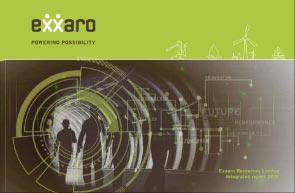
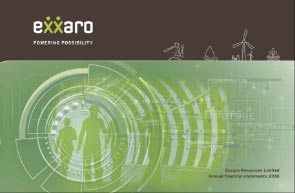
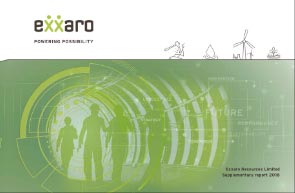
Currently viewing Supplementary Report 2018




Currently viewing Supplementary Report 2018

Dear shareholder
I am pleased to present the remuneration report and accompanying implementation report for the year to 31 December 2018 (FY18) for the Exxaro group of companies.
The way Exxaro remunerated its people in the review period reflects the context in which the company operated and the dynamics of the market, as well as its remuneration philosophy.
This report provides an overview of the remuneration policy for all employees, including executive directors, prescribed officers and senior management, as well as non-executive directors.
No changes were made to the remuneration policy in the review period. The remuneration philosophy and policy are available on our website, www.exxaro.com. As its name suggests, the implementation report details how we effected that remuneration policy and related incentive policies.
2017 shareholder vote
The non-binding vote on the 2017 remuneration report was:
The contributions made by shareholders are appreciated as is the positive way in which these interactions are taking place. One written concern was received from a shareholder on performance conditions for our long-term incentives. I, as chairman of the committee and senior managers interacted with this shareholder to understand the reason for the concern and explained Exxaro's position. The committee considered all feedback and has decided to retain current performance conditions which it believes provide an appropriate balance between stakeholder interests and operational focus.
Key remuneration decisions in 2018
Notable matters and key areas of focus for the committee for the review period included:
The company assisted by Deloitte conducted an impact study on vesting of the 2015, 2016 and 2017 LTIP and DBP awards as well as the planned 2018 LTIP and DBP grants, taking into account two significant corporate transactions:
The committee approved: all BEE transaction costs incurred by Exxaro, including interest paid by Eyesizwe (RF) Proprietary Limited (Eyesizwe), be reversed when calculating HEPS for vesting calculations.
The accounting treatment of the BEE transaction states that shares held by Eyesizwe in Exxaro should be treated as treasury shares. This implies that Exxaro's issued share capital is reduced by 107 million shares in the HEPS calculation, which is not comparable to the number of shares in the base years.
The committee approved the impact of treasury shares be added back in calculating HEPS for vesting of the 2015, 2016 and 2017 awards.
The Tronox distribution resulted in a reduction in the share price. This negatively impacted LTIP and DBP participants' 2015 to 2017 value, as a portion of the company's assets had been permanently removed from its asset base. Participants should also be compensated for Tronox distributions on their unvested shares.
Although Tronox Limited's equity-accounted results had a negative impact on HEPS in prior years, which resulted in a lower base HEPS, it was anticipated that the equity-accounted results from Tronox Limited would return to positive territory. As the non-inclusion of Tronox Limited's equity-accounted results would not have a material negative impact on HEPS, it was recommended not to adjust for this in the HEPS vesting calculations.
The committee approved: an additional grant of shares be made to LTIP and DBP participants to compensate for potential loss from the decrease in the Exxaro share price after the Tronox special dividend.
Some 1.5 million additional shares at a cost of R213 million were granted to participants to compensate for offers made in 2015, 2016 and 2017.
The committee was satisfied that the approved adjustments would ensure the impact of the BEE and Tronox transactions did not affect LTIP and DBP participants negatively, while ensuring shareholders were not disadvantaged and permissible in terms of the scheme rules.
Remuneration advice
Exxaro continues to obtain independent and professional advice on remuneration matters. In the review period, we obtained advice from consultants who, in the view of the committee, can be regarded as fully independent:
Looking ahead
With the promulgation of the revised mining charter and implementation guidelines, a replacement ESOP will be developed in 2019. Internal 'smart workforce' initiatives will assist employees in acquiring the relevant knowledge and skills for the new world of work and the impact of digitalisation on the future of work. Smart workforce programmes include programmes on digitalisation and innovation, Microsoft 365, design thinking, data science and data mining, culture and leadership behaviours aligned to Exxaro's workforce of the future journey, creating a bias for action and more critically, job-specific reskilling at operating units and corporate office. These programmes were started and rolled out in 2018 and will be revised as business needs change.
2019 focus areas
In addition to its normal workplan, the committee will specifically focus on the following areas for 2019
In the view of the committee, Exxaro's remuneration strategy continues to deliver a sound value proposition to employees that drives value creation for stakeholders. Our vision for rewards is to provide simple, integrated, holistic solutions, common messages and a package differentiated from the market for Exxaro to attract, retain and energise talented, high-performing people. Remuneration has been fully integrated into other management processes such as performance management, talent management and human resources policies.
Exxaro understands that remuneration is critical in attracting and retaining high-performing individuals. As such, the committee firmly supports the principle that pay must be aimed at reinforcing, encouraging and promoting superior performance.
In 2018, Dr Con Fauconnier stepped down as non-executive director and chairman of this committee. We are deeply grateful for his guidance and wisdom over the years.
I thank my fellow committee members for their support and wise counsel in the review period. I also thank the executive head of human resources and her staff for their hard work and dedication in ensuring Exxaro remains competitive in the market and an employer of choice for all of its employees.
EJ Myburgh
Chairman
Remuneration and nomination committee
24 April 2019
2.1 Introduction
This report sets out Exxaro's remuneration policy for non-executive directors, executive directors, prescribed officers, senior management and all other employees.
The remuneration overview and accompanying implementation report are tabled in two separate resolutions every year for non-binding advisory votes by shareholders at the annual general meeting. Shareholders are required to express their views and vote on both the remuneration policy and its implementation.
The non-binding advisory vote provides an opportunity for shareholders to influence Exxaro's perspective on remuneration matters, specifically the structure of total remuneration in terms of policy (ie salary, benefits, short-term and long-term incentives) as well as implementation of the policy and how this translates to actual salaries, incentives and benefits.
The nature of the advisory vote is, therefore, feedback on the remuneration policy (forward-looking) and implementation of the policy (backward-looking).
If either this remuneration policy overview or accompanying implementation report are voted against by 25% or more of the voting rights exercised, the committee will again engage with significant shareholders to ascertain reasons for dissenting votes.
Legitimate objections and concerns are addressed. This can include amending the remuneration policy, as well as clarifying or adjusting remuneration governance and processes.
2.2 Remuneration philosophy, policy and framework
2.2.1 Remuneration philosophy and policy
Operational excellence, continuous improvement and innovation are the cornerstone of Exxaro's philosophy and remuneration.
Exxaro's remuneration philosophy and attendant policies are widely shared with employees and the public.
www.exxaro.com/workplace.
Remuneration policy
Exxaro's remuneration policy addresses the economics and ethics of remuneration, particularly fair and responsible remuneration for executive management in the context of overall remuneration. Cognisance has been taken of the gap between the general workforce and executive pay.
The policy provides for an annual assessment of the wage gap and consideration of any appropriate actions, such as differentiating annual adjustments. In addition, the principles of internal parity, reward for performance and market competitiveness apply (detailed in section 2.2.2). These principles facilitate fair and responsible remuneration.
Exxaro reward practices and outcomes are determined by:
| Strategy and purpose | The way we work | Performance | Market | |||||||
|
Supporting the business and people strategy |
Prohibiting discrimination as per the constitution (Republic of South Africa - Act 108 1996, as amended, and Employment Equity Act 55 1998, as amended) Encouraging employee engagement according to Exxaro's purpose through the total employee offering (financial and non-financial) Allowing maximum flexibility and choice in structuring individuals' rewards Seeking a balance between affordability and maximising employees' wellbeing |
Inspiring superior performance (at organisational, team and individual level) Facilitating the enhancement of skills, knowledge and experience Differentiating rewards appropriately according to our reward practices |
Exxaro makes extensive use of remuneration benchmarks against appropriate peer groups in chosen markets. The remuneration policy defines the market as country-specific companies, primarily in the mining industry, as well as functions attracting premium remuneration. We participate in a number of salary surveys to substantiate remuneration data. The ideal is for total remuneration to be on the 50th percentile of the market for full performance |
2.2.2 Fair and responsible remuneration principles
The guiding principles on remuneration arrangements for all employees, including executive management, are:
| Internal parity |
|
|||
| Market competitiveness |
|
|||
| Remuneration ranges |
|
|||
| Remuneration packages and benefits |
|
|||
| Reward for performance |
|
|||
| Remuneration-setting process |
|
|||
| Economics and ethics of remuneration |
|
|||
| Company performance and affordability |
|
|||
| Communicating remuneration issues |
|
2.2.3 Remuneration framework
The framework below depicts the type of remuneration and rewards for applicable employee categories.
| Remuneration | |||||||||||||||||||||||
| Employee category* | Guaranteed remuneration | Variable pay | |||||||||||||||||||||
| Short-term incentive schemes (STI) | Long-term incentives (LTI) | ||||||||||||||||||||||
| Notional cost of employment (NCOE |
Salary and benefits |
STI | Special performance award (SPR) |
LTIP | DBP | ESOP | |||||||||||||||||
| Executive management | x | x | x | x | x | ||||||||||||||||||
| Senior management | x | x | x | x | x | ||||||||||||||||||
| Middle management | x | x | x | x | |||||||||||||||||||
| Junior management | x | x | |||||||||||||||||||||
| Bargaining-unit employees | x | x | x | ||||||||||||||||||||
| * | Applicable employee categories (Paterson job gradings): |
| Executive management | Senior management | Middle management | Junior management | Bargaining-unit employees | |||||||||||||
| F band | E band | DU and DM band | CU and DL band | A-CM band | |||||||||||||
| Management and specialist | Other employees | ||||||||||||||||
2.3 Remuneration
2.3.1 Guaranteed remuneration
Exxaro's guaranteed remuneration refers to the notional cost of employment (NCOE, including basic salary and benefits) for management and specialist employees, as well as basic salary for bargaining-unit employees.
The average increase in 2018 was 7.25%. Since Exxaro was formed in 2006, bargaining-unit employees have generally received increases of 0.5 to 1.5% per annum higher than management and specialist-category employees to reduce the wage gap.
Notional cost of employment
NCOE is the guaranteed-remuneration portion of total pay and includes basic salary, benefits and retirement funding.
| NCOE | |
| Management and specialist employees | |
| Increase granted to NCOE: 7% Differentiated increases were given to employees based on performance and contribution. |
|
Annual adjustments based on:
|
|
Basic salary
All bargaining-unit employees receive a market-related basic salary as well as benefits (see full list of benefits below). Bargaining-unit employees have received increases of between 0.5% and 1.5% per annum higher than management and specialist-category employees over the years to reduce the wage gap.
| Basic salary | |
| Bargaining-unit employees | |
Increase granted to BS: 7.5% Coastal Coal: FerroAlloys: Exxaro Coal, Exxaro Coal Mpumalanga and Ferroland Grondtrust: |
|
Annual adjustments based on:
|
Benefits
All employees are entitled to the same range of benefits appropriate to their role level and specific circumstances. Management and specialist employees have flexibility in structuring their remuneration within certain company and legislative limitations.
| Benefits |
| Executive management, senior management, middle management, junior management, bargaining-unit employees |
|
Retirement funds* All employees are members of one of Exxaro's accredited retirement funds. Retirement fund contributions are determined by specific conditions of employment and fund rules for the different levels and categories of employees. Medical health schemes** Employees may annually elect to belong to any of the accredited medical schemes, as they apply to the relevant employees. Contributions are made by both employer and employee. Exxaro does not provide any post-retirement medical benefits. Group personal accident cover Employees are covered by a policy that provides additional cover for death, disability and dread disease. Other benefits Exxaro provides a range of other market-related conditions-of-service benefits. |
|
The committee annually evaluates benefits to:
|
| * | Retirement fund options |
| Exxaro-accredited retirement funds are defined-contribution funds. | |
| Fund description | Employee contribution range | Employer contribution range | Total contribution range | |||
| Sentinel Funds | 7.5 - 13.2% | 12.5 - 20.52% | 20 - 28.02% | |||
| Exxaro Pension and Provident Funds | 7 - 8% | 10 - 15% | 17 - 23% | |||
| Iscor Employees Umbrella Provident Fund | 7 - 8% | 10 - 15% | 17 - 23% | |||
| Mine Workers Provident Fund | 8 - 10.7% | 12.5 - 15% | 20.5 - 24.65% |
| *** | Medical health scheme options |
| Employer | Exxaro Coal and Exxaro Coal Mpumalanga | Exxaro Resources Limited (including management and specialist employees in subsidiary companies) | Exxaro (other non-management and specialist employees) | ||||
| Fund names | Bonitas | Bonitas | Bonitas | ||||
| Discovery | Discovery | Sizwe | |||||
| Sizwe | Sizwe | Umvuzo | |||||
| Umvuzo | Umvuzo | ||||||
| Employer contributions | Main member: 60% Dependants: 50% | Included in NCOE package | 60% capped at R value | ||||
| Employee contributions | Main member: 40% Dependants: 50% | 40% |
Exxaro does not provide any post-retirement medical benefits. The post-retirement benefit obligation disclosed in the annual financial statements recognises a past practice (in Eyesizwe Proprietary Limited) that was discontinued with the creation of Exxaro in November 2006.
Circumstantial remuneration may be awarded in the following instances: job-specific, skills scarcity and severance payments.
2.3.2 Variable pay
Short-term incentives
Exxaro's short-term incentive schemes are based on individual, business unit, commodity and group-level performance. Exxaro has two short-term incentive schemes: the special performance reward (SPR) and the two-tier short-term incentive (STI).
| Special performance reward (SPR) | |||||||||||||||||||||||||||||||||||||||||||||||||||||||||
| Executive management, senior management and middle management. | |||||||||||||||||||||||||||||||||||||||||||||||||||||||||
| Yearly SPR objectives are set. At the end of the year, a five-point rating scale is used to evaluate achievement of objectives. | |||||||||||||||||||||||||||||||||||||||||||||||||||||||||
| Scoring | |||||||||||||||||||||||||||||||||||||||||||||||||||||||||
|
|||||||||||||||||||||||||||||||||||||||||||||||||||||||||
| Payment factors per job grade: | |||||||||||||||||||||||||||||||||||||||||||||||||||||||||
|
|||||||||||||||||||||||||||||||||||||||||||||||||||||||||
| Rewards are paid to those who qualify at the end of March of the following year. | |||||||||||||||||||||||||||||||||||||||||||||||||||||||||
| Two-tier incentive scheme (STI) | ||||
| Executive management, senior management, middle management, junior management and bargaining-unit employees. | ||||
| The two-tier incentive scheme is based on business performance | ||||
Tier one The potential value, provided all budgeted operational targets have been achieved for the year, is a maximum of 8.33% of gross annual remuneration. The graph shows performance target reached versus payout percentage of gross annual remuneration:
|
||||
Tier two The second tier is based on exceeding a combination of budgeted consolidated net operating profit and production targets by an improvement percentage at commodity business unit and group level. The potential value, provided all targets have been achieved for the year, is 10% of gross annual remuneration. |
||||
Long-term incentives
Exxaro makes general share offers to participants once a year under the LTIP and DBP.
| Long-term incentive plan (LTIP) | Deferred bonus plan (DBP) | ||||
| Executive management Senior management Middle management |
Executive management Senior management |
||||
|
Remco can make a conditional award to qualifying employees. Awards vest after three years, subject to fulfilling the following performance conditions:
|
Remco can select participants based on seniority and performance. The after-tax portion of the STI and SPR payments are used to acquire pledged shares. The pledged shares are held in escrow until the vesting date after three years. At the end of the three-year period, these are matched with an award to the participant of shares equal to the market value of pledged shares on the vesting date. |
An employee share option scheme, known as Exxaro Mpower 2012* (ESOP), wound up on 31 May 2017; a replacement scheme will be developed in 2019.
*Exxaro Mpower 2012
In 2018, participants who received payments equal to the three dividends paid to shareholders received a total payment of R10 925.
We anticipate that a new ESOP will be introduced in 2019.
Costs of payments made to all participants in 2018
| Active participants | Number of units | Payment before tax | Payment | |||||
| Special cash dividend (13 February 2018) of 1 255 cents per share | 6 004 | 2 982 560 | R37 431 128 | R29 944 902 | ||||
| Final cash dividend (6 March 2018) of 400 cents per share | 6 019 | 2 984 320 | R11 937 280 | R9 549 824 | ||||
| Interim cash dividend (14 August 2018) of 530 cents per share | 6 037 | 2 952 900 | R15 650 370 | R1 5220 296 |
2.4 Remuneration mix
Below we show the total remuneration pay mix for executive management, applying the remuneration policy under minimum, on-target and maximum performance outcomes:
| CEO: pay mix (%) | Prescribed officer (on Paterson band F-lower): pay mix (%) | |
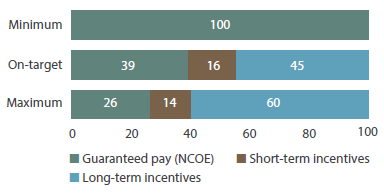 |
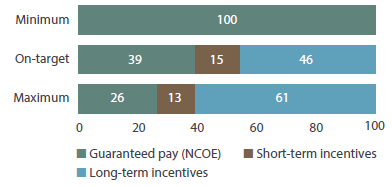 |
|
| Finance director: pay mix (%) | Prescribed officer (on Paterson band E-upper): pay mix (%) | |
 |
 |
|
2.5 Employment contracts
Executive long-term incentives
Executive employment contracts for management are generally valid for an indefinite period, with a notice period of three to six months or payment in lieu.
The current executive employment contracts do not have a restraint-of-trade clause, but include confidentiality undertakings.
Employment contracts provide for the following payments on termination:
Note that there are no special agreements in place on severance packages for executive employees.
Fees for non-executive directors are reviewed annually, and independent data is used for benchmarking.
Fees are paid as a combination of retainer and fee per meeting in line with emerging market practice and company culture.
3.1 Introduction
This implementation report discloses remuneration outcomes for non-executive directors, executive directors and prescribed officers. This includes a single, total figure of remuneration received and receivable for the review period and all constituent remuneration elements at fair value.
In addition, details of all awards made under the Exxaro variable compensation schemes are disclosed under sections for short-term and long-term incentives. This includes reference to awards in current and prior years that have not yet vested, vesting and expiry dates where applicable, the fair value at the end of the review year, as well as the cash value of awards settled. The performance measures used and their weighting is disclosed.
In the review period, implementation complied fully with the remuneration policy.
3.2 Remuneration of executive management
Total remuneration is summarised below by name and role for FY18 and FY17. We disclose the performance rating for each executive director and prescribed officer supporting the SPR, as well as tier-one and tier-two factors achieved under the STI scheme. We also disclose the outcome of the 2015 and 2016 conditional LTIP awards that vested in 2018. Vesting in that period was subject to the following performance metrics:
In FY18, 100% of conditional awards made to participants vested because the HEPS target was achieved. No further performance conditions apply to the DBP scheme, other than continued employment at the time of vesting.
| MDM Mgojo: Chief executive officer | PA Koppeschaar: Finance executive. | |
| Remuneration outcomes (Rm) | Remuneration outcomes (Rm) | |
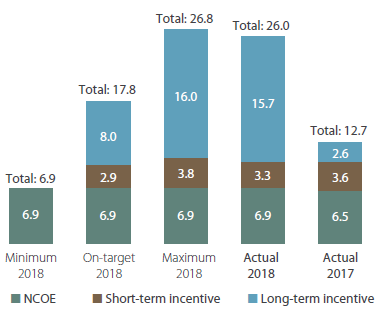 |
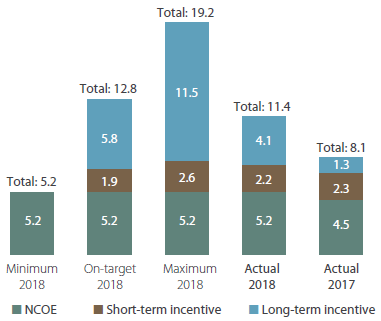 |
|
| SPR objectives | Rating | ||||
| Implement ESD strategy as per plan | 4 | ||||
| Signed agreement for Arnot BEE transaction | 4 | ||||
| Implement business excellence initiatives and adopt lean practices | 4 | ||||
| Overall rating | 4 | ||||
| STI tier-one factor (max 8.33%) | 8.33% | ||||
| STI tier-two factor (max 10%) | 2.58% | ||||
| LTIP As above, awards vested in 2018 | |||||
| SPR objectives | Rating | ||||
| Ensure a plan is in place to monetise remaining Tronox shareholding | 4 | ||||
| Implement business excellence initiatives and adopt lean practices | 4 | ||||
| Overall rating | 4 | ||||
| STI tier-one factor (max 8.33%) | 8.33% | ||||
| STI tier-two factor (max 10%) | 2.58% | ||||
| LTIP As above, awards vested in 2018 | |||||
| V Balgobind: Executive head of human resources |
| Remuneration outcomes (Rm) |
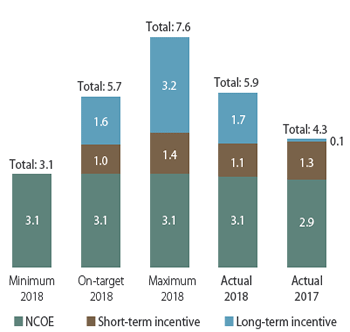 |
| SPR objectives | Rating | ||||
| Implement culture initiative | 4 | ||||
| Strategy finalised and implement workforce of the future | 4 | ||||
| Implement business excellence initiatives and adopt lean practices | 4 | ||||
| Overall rating | 4 | ||||
| STI tier-one factor (max 8.33%) | 8.33% | ||||
| STI tier-two factor (max 10%) | 2.58% | ||||
| LTIP As above, awards vested in 2018 |
| AW Diedericks: Executive head of business development | JG Meyer: Executive head of projects and technology | |
| Remuneration outcomes (Rm) | Remuneration outcomes (Rm) | |
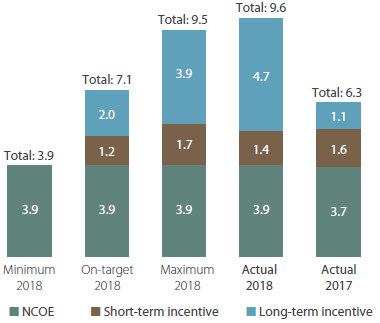 |
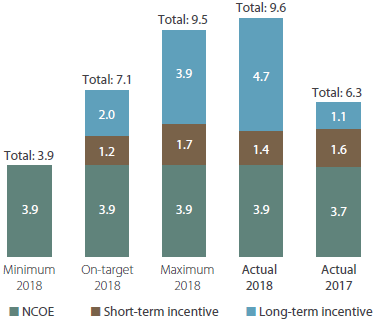 |
|
| SPR objectives | Rating | ||||
| Implement business excellence initiatives and adopt lean practices | 4 | ||||
| Value-chain analyses completed for top 3 materials | 4 | ||||
| Divest from Arnot according to plan | 4 | ||||
| Overall rating | 4 | ||||
| STI tier-one factor (max 8.33%) | 8.33% | ||||
| STI tier-two factor (max 10%) | 2.58% | ||||
| LTIP As above, awards vested in 2018 |
| SPR objectives | Rating | ||||
| Implement business excellence initiatives and adopt lean practices | 4 | ||||
| Large and mega project dashboard – digitalised and real-time | 4 | ||||
| Exxaro lakeside development project and change management (incl Belfast) | 4 | ||||
| Overall rating | 4 | ||||
| STI tier-one factor (max 8.33%) | 8.33% | ||||
| STI tier-two factor (max 10%) | 2.58% | ||||
| LTIP As above, awards vested in 2018 |
| MI Mthenjane: Executive head of stakeholder affairs |
| Remuneration outcomes (Rm) |
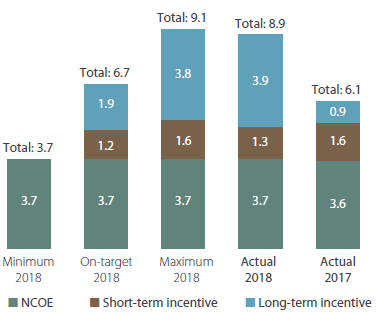 |
| SPR objectives | Rating | ||||
| Full implementation of project to diversify Exxaro shareholder base by geography and investment theme (mining versus non-mining) | 3 | ||||
| Roll out ESD strategy using innovative solutions | 4 | ||||
| Implement business excellence initiatives and adopt lean practices | 4 | ||||
| Achieved 100% of Q2 maturity assessment target for business excellence – lean enablement | 4 | ||||
| Overall rating | 4 | ||||
| STI tier-one factor (max 8.33%) | 8.33% | ||||
| STI tier-two factor (max 10%) | 2.58% | ||||
| LTIP As above, awards vested in 2018 |
| N Tsengwa: Executive head of coal operations | M Veti: Executive head of sustainability | |
| Remuneration outcomes (Rm) | Remuneration outcomes (Rm) | |
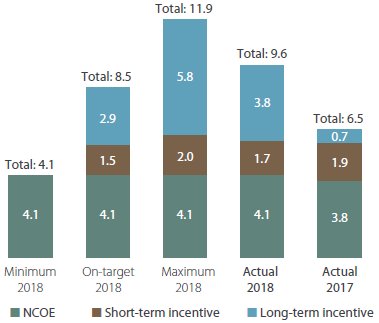 |
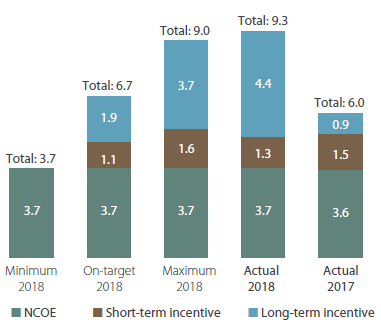 |
|
| SPR objectives | Rating | ||||
| Coal strategy implementation | 4 | ||||
| Contractor optimisation | 4 | ||||
| Visibility ‘ops eye’ at two business units | 4 | ||||
| Overall rating | 4 | ||||
| STI tier-one factor (max 8.33%) | 8.33% | ||||
| STI tier-two factor (max 10%) | 2.58% | ||||
| LTIP As above, awards vested in 2018 |
| SPR objectives | Rating | ||||
| Resolve dispute for transfer/relinquishment of 720 000Mt to Marubeni IPP in favour of Exxaro | 4 | ||||
| Licence approved for NBC transaction condition precedent | 4 | ||||
| Implement business excellence initiatives and adopt lean practices | 4 | ||||
| Overall rating | 4 | ||||
| STI tier-one factor (max 8.33%) | 8.33% | ||||
| STI tier-two factor (max 10%) | 2.58% | ||||
| LTIP As above, awards vested in 2018 |
| SE van Loggerenberg: Company secretary |
| Remuneration outcomes (Rm) |
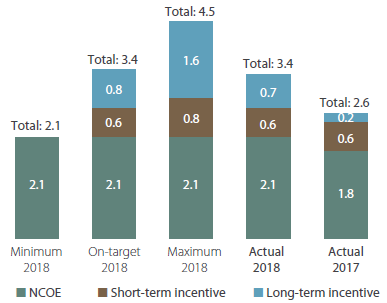 |
| SPR objectives | Rating | ||||
| Implement business excellence initiatives and adopt lean practices | 4 | ||||
| Replacing BoardPad with Diligent | 4 | ||||
| Overall rating | 4 | ||||
| STI tier-one factor (max 8.33%) | 8.33% | ||||
| STI tier-two factor (max 10%) | 2.58% | ||||
| LTIP As above, awards vested in 2018 |
The table alongside outlines the detailed remuneration of executives. Please note that:
| Executive | Year | NCOE | Short- term incentives |
Long- term incentives |
Total remuneration | Year-on-year increase |
Other payments |
|||||||
| MDM Mgojo |
2018 | 6 933 519 | 3 321 854 | 15 701 939 | 25 957 312 | 104.6% | 200 240 | |||||||
| Chief executive officer | 2017 | 6 503 463 | 3 598 366 | 2 585 196 | 12 687 025 | 2 530 | ||||||||
| PA Koppeschaar |
2018 | 5 163 873 | 2 215 820 | 4 057 988 | 11 437 681 | 41.3% | 10 760 | |||||||
| Finance executive | 2017 | 4 520 625 | 2 275 231 | 1 301 286 | 8 097 142 | 2 530 | ||||||||
| V Balgobind |
2018 | 3 135 624 | 1 126 004 | 1 669 362 | 5 930 990 | 37.6% | 6 956 | |||||||
| Executive head: human resources | 2017 | 2 908 065 | 1 260 065 | 143 678 | 4 311 808 | 32 730 | ||||||||
| AW Diedericks |
2018 | 3 818 186 | 1 371 114 | 4 700 652 | 9 889 952 | 55.9% | 5 260 | |||||||
| Executive head: business development | 2017 | 3 688 623 | 1 598 280 | 1 058 546 | 6 345 449 | 60 323 | ||||||||
| JG Meyer |
2018 | 3 895 210 | 1 398 774 | 4 670 528 | 9 964 512 | 56.9% | 5 260 | |||||||
| Executive head: projects and technology | 2017 | 3 688 623 | 1 598 280 | 1 063 570 | 6 350 473 | 60 330 | ||||||||
| MI Mthenjane |
2018 | 3 747 913 | 1 345 878 | 3 874 158 | 8 967 949 | 47.8% | 6 260 | |||||||
| Executive head: stakeholder affairs | 2017 | 3 612 482 | 1 565 289 | 889 223 | 6 066 994 | 2 530 | ||||||||
| Dr N Tsengwa |
2018 | 4 070 181 | 1 746 518 | 3 770 366 | 9 587 065 | 47.1% | 69 942 | |||||||
| Executive head: coal operations | 2017 | 3 842 326 | 1 933 844 | 741 789 | 6 517 959 | 2 530 | ||||||||
| SE van Loggerenberg |
2018 | 2 092 998 | 646 948 | 698 287 | 3 438 233 | 34.5% | 21 310 | |||||||
| Company secretary | 2017 | 1 791 590 | 615 239 | 149 382 | 2 556 211 | 7 030 | ||||||||
| M Veti |
2018 | 3 696 666 | 1 327 476 | 4 364 615 | 9 388 757 | 55.7% | 6 260 | |||||||
| Executive head: sustainability | 2017 | 3 571 190 | 1 547 397 | 910 083 | 6 028 670 | 2 530 |
3.4 Awards under short-term incentive schemes
The following incentives were paid in 2018 under the SPR and STI. In the table below, we disclose the performance rating for each executive director and prescribed officer supporting the SPR as well as tier-one and tier-two factors achieved under the STI scheme. All payments were made as per policy, and there were no deviations.
| SPR | STI | ||||||||||
| Name | NCOE R |
Rating | SPR factor |
Actual R |
Tier one factor | Tier two factor | Total factor |
Actual R |
Total short-term incentive R |
Short-terml incentive as % rating of NCOE |
|
| MDM Mgojo | 6 933 519 | 4 | 37.0% | 2 565 402 | 8.33% | 2.58% | 10.9% | 756 447 | 3 321 854 | 47.9% | |
| PA Koppeschaar | 5 163 873 | 4 | 32.0% | 1 652 439 | 8.33% | 2.58% | 10.9% | 563 379 | 2 215 820 | 42.9% | |
| V Balgobind | 3 135 624 | 4 | 25.0% | 783 906 | 8.33% | 2.58% | 10.9% | 342 097 | 1 126 004 | 35.9% | |
| AW Diedericks | 3 818 186 | 4 | 25.0% | 954 547 | 8.33% | 2.58% | 10.9% | 416 564 | 1 371 114 | 35.9% | |
| JG Meyer | 3 895 210 | 4 | 25.0% | 973 803 | 8.33% | 2.58% | 10.9% | 424 967 | 1 398 774 | 35.9% | |
| MI Mthenjane | 3 747 913 | 4 | 25.0% | 936 978 | 8.33% | 2.58% | 10.9% | 408 897 | 1 345 878 | 35.9% | |
| Dr N Tsengwa | 4 070 181 | 4 | 32.0% | 1 302 458 | 8.33% | 2.58% | 10.9% | 444 057 | 1 746 518 | 42.9% | |
| SE van Loggerenberg | 2 092 998 | 4 | 20.0% | 418 600 | 8.33% | 2.58% | 10.9% | 228 346 | 646 948 | 30.9% | |
| M Veti | 3 696 666 | 4 | 25.0% | 924 167 | 8.33% | 2.58% | 10.9% | 403 306 | 1 327 476 | 35.9% | |
| Total | 36 554 170 | 14 500 386 | |||||||||
For the two-tier STI, the 2018 results of tier one and two are shown below, resulting in the performance bonuses noted above as well as at various business units.
A business unit will qualify for tier one and/or tier two on a sliding scale between a threshold of 90% and 100% performance against targets. Modifiers apply where stated.
| Tier one (max) | 8.33% | |
| Commercial business units | Total FY18 achievement | |
| Grootegeluk | 8.33% | |
| Leeuwpan | 8.33% | |
| NBC* | 4.77% | |
| Mafube | 8.00% | |
| Operating commodity businesses | 8.33% | |
| FerroAlloys | 8.33% | |
| Corporate and services | 8.33% | |
| Ferroland | 7.47% | |
| Belfast | 8.33% | |
| Closure | ||
| Arnot | 8.33% | |
| Coastal Coal - Durnacol and Hlobane | 8.13% | |
| Coastal Coal - Tshikondeni | 7.80% | |
| * | NBC divestment effective 1 November 2018. |
| Tier two (max) | ||
| Commercial business units | Total FY18 achievement | |
| Grootegeluk | 2.58% | |
| Leeuwpan | 2.58% | |
| NBC* | 1.48% | |
| Mafube | 2.48% | |
| Operating commodity businesses | 2.58% | |
| FerroAlloys | 2.58% | |
| Corporate and services | 2.58% | |
| Ferroland | 2.38% | |
| Belfast | 2.58% | |
| Closure | ||
| Arnot | 2.58% | |
| Coastal Coal - Durnacol and Hlobane | 2.52% | |
| Coastal Coal - Tshikondeni | 2.42% |
| * | NBC divestment effective 1 November 2018. |
Exxaro Coal Central:
Employees do not participate in STI and SPR. A different incentive applies. On average, employees received incentives totalling 27.7% of annual remuneration.
3.5 Awards made under long-term incentive schemes
Below we detail our two long-term (share-based) incentive schemes:
LTIP
Conditional LTIP awards made between April 2015 and March 2016 vested in FY18. Vesting was subject to the following performance metrics:
The minimum performance condition is that Exxaro's HEPS for FY17 is equal to HEPS for FY14. The table summarises HEPS performance:
| HEPS1 | ||
| Base: December 20142 | 1 371 | |
| Target: December 20173 | 1 689 | |
| Actual: December 20174 | 1 881 | |
| Lower target met | Yes | |
| Upper target met | Yes | |
| 1 | HEPS is measured in cents per share. |
| 2 | Based on actual HEPS achieved for FY14. |
| 3 | Based on a targeted performance for FY17 (base multiplied by a cumulative increase of 123.3%). |
| 4 | Based on actual HEPS achieved for FY17. |
100% of conditional awards made to participants vested because the HEPS target was achieved.
DBP
No further performance conditions apply to this scheme other than continued employment at the time of vesting.
LTIP
The table below illustrates the rights held by each participant as well as options exercised and shares forfeited due to performance conditions not being met in the review period.
| 2018 | Rights held at 31 December |
Exercisable period | Pre-tax gain if exercisable at 31 December1 | Modification during the year2 | Options exercised during the year | Shares forfeited3 | Sale price/ market price |
Pre-tax gain |
Date exercised |
||||||||
| MDM Mgojo | 01/04/2018 | 6 105 | 74 925 | 106.43 | 7 974 268 | 03/04/2018 | |||||||||||
| 01/05/2018 | 5 667 | 69 556 | 111.10 | 7 727 672 | 04/05/2018 | ||||||||||||
| 206 388 | 01/04/2019 | 28 454 714 | 16 816 | ||||||||||||||
| 139 908 | 01/04/2020 | 19 289 116 | 11 399 | ||||||||||||||
| 152 820 | 01/04/2021 | 21 069 293 | |||||||||||||||
| 499 116 | 68 813 123 | 39 987 | 144 481 | 15 701 940 | |||||||||||||
| PA Koppeschaar | 01/04/2018 | 2 940 | 36 077 | 106.43 | 3 839 675 | 03/04/2018 | |||||||||||
| 51 770 | 01/04/2019 | 7 137 530 | 4 218 | ||||||||||||||
| 36 287 | 01/09/2019 | 5 002 889 | 2 957 | ||||||||||||||
| 60 728 | 01/04/2020 | 8 372 569 | 4 948 | ||||||||||||||
| 71 749 | 01/04/2021 | 9 892 035 | |||||||||||||||
| 220 534 | 30 405 023 | 15 063 | 36 077 | 3 839 675 | |||||||||||||
| V Balgobind | 01/04/2018 | 170 | 2 085 | 4 468 | 106.43 | 221 907 | 03/04/2018 | ||||||||||
| 01/04/2018 | 1 063 | 13 045 | 106.43 | 1 388 379 | 03/04/2018 | ||||||||||||
| 41 655 | 01/04/2019 | 5 742 975 | 3 394 | ||||||||||||||
| 21 760 | 01/04/2019 | 3 000 051 | 1 773 | ||||||||||||||
| 27 336 | 01/04/2020 | 3 768 814 | 2 228 | ||||||||||||||
| 30 331 | 01/04/2021 | 4 181 735 | |||||||||||||||
| 121 082 | 16 693 575 | 8 628 | 15 130 | 4 468 | 1 610 286 | ||||||||||||
| AW Diedericks | 01/04/2018 | 3 051 | 37 438 | 106.43 | 3 984 526 | 03/04/2018 | |||||||||||
| 53 725 | 01/04/2019 | 7 407 066 | 4 378 | ||||||||||||||
| 34 553 | 01/04/2020 | 4 763 822 | 2 816 | ||||||||||||||
| 36 500 | 01/04/2021 | 5 032 255 | |||||||||||||||
| 124 778 | 17 203 143 | 10 245 | 37 438 | 3 984 526 |
| 2018 | Rights held at 31 December |
Exercisable period | Pre-tax gain if exercisable at 31 December1 | Modification during the year2 | Options exercised during the year |
Sale price/ market price |
Pre-tax gain |
Date exercised |
| JG Meyer | 01/04/2018 | 3 051 | 37 438 | 106.43 | 3 984 526 | 03/04/2018 | ||
| 53 725 | 01/04/2019 | 7 407 066 | 4 378 | |||||
| 34 553 | 01/04/2020 | 4 763 822 | 2 816 | |||||
| 37 475 | 01/04/2021 | 5 166 678 | ||||||
| 125 753 | 17 337 566 | 10 245 | 37 438 | 3 984 526 | ||||
| MI Mthenjane | 01/04/2018 | 2 966 | 36 401 | 106.43 | 3 874 158 | 03/04/2018 | ||
| 52 237 | 01/04/2019 | 7 201 915 | 4 256 | |||||
| 33 916 | 01/04/2020 | 4 675 999 | 2 764 | |||||
| 35 828 | 01/04/2021 | 4 939 606 | ||||||
| 121 981 | 16 817 520 | 9 986 | 36 401 | 3 874 158 | ||||
| Dr N Tsengwa | 01/04/2018 | 2 566 | 31 488 | 106.43 | 3 351 268 | 03/04/2018 | ||
| 45 187 | 01/04/2019 | 6 229 932 | 3 682 | |||||
| 26 964 | 01/05/2019 | 3 717 527 | 2 197 | |||||
| 51 117 | 01/04/2020 | 7 047 501 | 4 165 | |||||
| 55 441 | 01/04/2021 | 7 643 651 | ||||||
| 178 709 | 24 638 611 | 12 610 | 31 488 | 3 351 268 | ||||
| SE van Loggerenberg | 01/04/2018 | 535 | 6 561 | 106.43 | 698 287 | 03/04/2018 | ||
| 9 414 | 01/04/2019 | 1 297 908 | 767 | |||||
| 6 191 | 01/04/2020 | 853 553 | 505 | |||||
| 7 198 | 01/10/2020 | 992 388 | 587 | |||||
| 15 272 | 01/04/2021 | 2 105 551 | ||||||
| 38 075 | 5 249 400 | 2 394 | 6 561 | 698 287 | ||||
| M Veti | 01/04/2018 | 2 953 | 36 244 | 106.43 | 3 857 449 | 03/04/2018 | ||
| 52 013 | 01/04/2019 | 7 171 032 | 4 238 | |||||
| 33 452 | 01/04/2020 | 4 612 027 | 2 726 | |||||
| 35 338 | 01/04/2021 | 4 872 050 | ||||||
| 120 803 | 16 655 109 | 9 917 | 36 244 | 3 857 449 |
| 1 | Based on a share price of R137.87 on 31 December 2018. |
| 2 | A modification made to the LTIP scheme in 2018 resulted in a top-up in the number of rights employees are entitled to. This was to provide for the Tronox disposal and subsequent special dividend (Tronox distribution) which would have a negative impact on the value of the company’s future share price and scheme participants who would lose out on the Tronox distribution on their unvested shares. |
| 3 | Shares forfeited due to performance conditions not being adequately met. |
DBP
The table below illustrates the rights held by each participant as well as options exercised and shares forfeited as a result of resignations in the review period.
| 2018 | Rights held at 31 December | Exercisable period | Pre-tax gain if exercisable at 31 December1 | Modification during the year2 | Options exercised during the year |
Sale price/ market price |
Pre-tax gain |
Date exercised |
||||||||
| MDM Mgojo | 6 314 | 04/03/2019 | 870 511 | 515 | ||||||||||||
| 11 444 | 31/03/2019 | 1 577 784 | 933 | |||||||||||||
| 1 507 | 31/08/2019 | 207 770 | 123 | |||||||||||||
| 1 140 | 31/08/2020 | 157 172 | 93 | |||||||||||||
| 4 124 | 09/03/2021 | 568 576 | ||||||||||||||
| 10 509 | 31/03/2021 | 1 448 876 | ||||||||||||||
| 946 | 31/08/2021 | 130 425 | ||||||||||||||
| 35 984 | 4 961 114 | 1 664 | ||||||||||||||
| PA Koppeschaar | 31/03/2018 | 119 | 1 456 | 149.94 | 218 313 | 09/05/2018 | ||||||||||
| 690 | 31/08/2021 | 95 130 | ||||||||||||||
| 690 | 95 130 | 119 | 1 456 | 218 313 | ||||||||||||
| V Balgobind | 31/08/2018 | 33 | 394 | 149.94 | 59 076 | 11/09/2018 | ||||||||||
| 1 836 | 04/03/2019 | 253 129 | 150 | |||||||||||||
| 2 040 | 31/03/2019 | 281 255 | 167 | |||||||||||||
| 386 | 31/08/2019 | 53 218 | 32 | |||||||||||||
| 994 | 09/03/2020 | 137 043 | 81 | |||||||||||||
| 1 784 | 31/03/2020 | 245 960 | 146 | |||||||||||||
| 285 | 31/08/2020 | 39 293 | 24 | |||||||||||||
| 1 027 | 09/03/2021 | 141 592 | ||||||||||||||
| 1 773 | 31/03/2021 | 244 444 | ||||||||||||||
| 238 | 31/08/2021 | 32 813 | ||||||||||||||
| 10 363 | 1 428 747 | 633 | 394 | 59 076 | ||||||||||||
| AW Diedericks | 06/03/2018 | 58 | 707 | 125.15 | 88 481 | 14/03/2018 | ||||||||||
| 31/03/2018 | 321 | 3 939 | 106.43 | 419 228 | 04/04/2018 | |||||||||||
| 31/08/2018 | 114 | 1 390 | 149.94 | 208 417 | 05/09/2018 | |||||||||||
| 3 650 | 04/03/2019 | 503 226 | 298 | |||||||||||||
| 5 339 | 31/03/2019 | 736 088 | 435 | |||||||||||||
| 869 | 31/08/2019 | 119 809 | 71 | |||||||||||||
| 2 270 | 09/03/2020 | 312 965 | 185 | |||||||||||||
| 4 121 | 31/03/2020 | 568 162 | 336 | |||||||||||||
| 649 | 31/08/2020 | 89 478 | 53 | |||||||||||||
| 2 343 | 09/03/2021 | 323 029 | ||||||||||||||
| 4 044 | 31/03/2021 | 557 546 | ||||||||||||||
| 525 | 31/08/2021 | 72 382 | ||||||||||||||
| 23 810 | 3 282 685 | 1 871 | 6 036 | 716 126 | ||||||||||||
| JG Meyer | 06/03/2018 | 55 | 669 | 125.15 | 83 725 | 15/03/2018 | ||||||||||
| 31/03/2018 | 307 | 3 757 | 106.43 | 399 858 | 04/04/2018 | |||||||||||
| 31/08/2018 | 110 | 1 350 | 149.94 | 202 419 | 03/09/2018 | |||||||||||
| 875 | 31/08/2019 | 120 636 | 72 | |||||||||||||
| 2 276 | 09/03/2020 | 313 792 | 186 | |||||||||||||
| 4 127 | 31/03/2020 | 568 989 | 337 | |||||||||||||
| 649 | 31/08/2020 | 89 478 | 53 | |||||||||||||
| 7 927 | 1 092 895 | 1 120 | 5 776 | 686 002 | ||||||||||||
| MI Mthenjane | 1 230 | 09/03/2020 | 169 580 | 101 | ||||||||||||
| 632 | 31/08/2020 | 87 134 | 52 | |||||||||||||
| 1 269 | 09/03/2021 | 174 957 | ||||||||||||||
| 2 199 | 31/03/2021 | 303 176 | ||||||||||||||
| 5 330 | 734 847 | 153 | ||||||||||||||
| Dr N Tsengwa | 06/03/2018 | 80 | 976 | 125.15 | 122 146 | 16/03/2018 | ||||||||||
| 31/03/2018 | 161 | 1 973 | 106.43 | 209 986 | 12/04/2018 | |||||||||||
| 31/08/2018 | 48 | 580 | 149.94 | 86 965 | 10/09/2018 | |||||||||||
| 2 596 | 31/03/2019 | 357 911 | 212 | |||||||||||||
| 439 | 31/08/2019 | 60 525 | 36 | |||||||||||||
| 1 234 | 09/03/2020 | 170 132 | 101 | |||||||||||||
| 373 | 31/08/2020 | 51 426 | 31 | |||||||||||||
| 250 | 31/08/2021 | 34 468 | ||||||||||||||
| 4 892 | 674 462 | 669 | 3 529 | 419 097 | ||||||||||||
| M Veti | 06/03/2018 | 37 | 453 | 125.15 | 56 693 | 14/03/2018 | ||||||||||
| 13/05/2018 | 229 | 2 810 | 118.05 | 331 721 | 23/05/2018 | |||||||||||
| 31/08/2018 | 65 | 792 | 149.94 | 118 752 | 11/09/2018 | |||||||||||
| 470 | 31/08/2019 | 64 799 | 39 | |||||||||||||
| 1 199 | 09/03/2020 | 165 306 | 98 | |||||||||||||
| 348 | 09/03/2020 | 47 979 | 29 | |||||||||||||
| 1 251 | 31/08/2020 | 172 475 | ||||||||||||||
| 2 183 | 31/03/2021 | 300 970 | ||||||||||||||
| 284 | 31/08/2021 | 39 155 | ||||||||||||||
| 5 735 | 790 684 | 497 | 4 055 | 507 166 |
| 1 | Based on a share price of R137.87 on 31 December 2018. |
| 2 | A modification to the DBP scheme in 2018 resulted in a top-up in the number of rights employees are entitled to. This was to provide for the Tronox disposal and subsequent special dividend (Tronox distribution) which would have a negative impact on the value of the company’s future share price and scheme participants who would lose out on the Tronox distribution on their unvested shares. |
3.2 Non-executive director fees and basis for fee-setting
Details are provided by name and role for the review period and 2017, with explanations where necessary.
| 2018 | 2017 | |||||||
| Non-executive directors | Fees for services R |
Benefits and allowances6 R |
Total R |
Fees for services R |
Benefits and allowances6 R |
Total R |
||
| S Dakile-Hlongwane1 | 44 731 | 44 731 | 553 756 | 4 190 | 557 946 | |||
| Dr CJ Fauconnier2 | 365 317 | 7 105 | 372 422 | 1 124 340 | 30 044 | 1 154 384 | ||
| GJ Fraser-Moleketi3 | 452 448 | 6 164 | 458 612 | |||||
| MW Hlahla4 | 430 791 | 430 791 | 387 528 | 3 931 | 391 459 | |||
| Dr D Konar2 | 608 524 | 608 524 | 1 783 803 | 1 783 803 | ||||
| D Mashile-Nkosi5 | 351 335 | 1 100 | 352 435 | |||||
| S Mayet2 | 168 215 | 1 100 | 169 315 | 372 034 | 1 100 | 373 134 | ||
| L Mbatha5 | 454 453 | 9 641 | 464 094 | |||||
| VZ Mntambo4 | 582 452 | 582 452 | 498 967 | 498 967 | ||||
| MJ Moffett3 | 429 745 | 429 745 | ||||||
| LI Mophatlane3 | 618 419 | 4 841 | 623 260 | |||||
| EJ Myburgh | 818 481 | 17 503 | 835 984 | 501 061 | 9 887 | 510 948 | ||
| V Nkonyeni | 767 230 | 18 275 | 785 505 | 532 156 | 532 156 | |||
| MF Randera1 | 80 534 | 3 159 | 83 693 | 486 834 | 10 764 | 497 598 | ||
| J van Rooyen (chairman) | 1 494 465 | 1 494 465 | 748 806 | 748 806 | ||||
| A Sing5 | 566 327 | 2 410 | 568 737 | |||||
| PCCH Snyders | 751 525 | 70 633 | 822 158 | 556 462 | 31 286 | 587 748 | ||
| D Zihlangu1 | 91 633 | 91 633 | 482 848 | 10 963 | 493 811 | |||
| Total | 9 076 625 | 141 931 | 9 218 556 | 8 028 595 | 102 165 | 8 130 760 |
| 1 | Resigned 6 March 2018. |
| 2 | Retired 24 May 2018. |
| 3 | Appointed 23 May 2018. |
| 4 | Resigned and reappointed 6 March 2018. |
| 5 | Appointed 6 March 2018. |
| 6 | Includes travelling and subsistence allowance. |